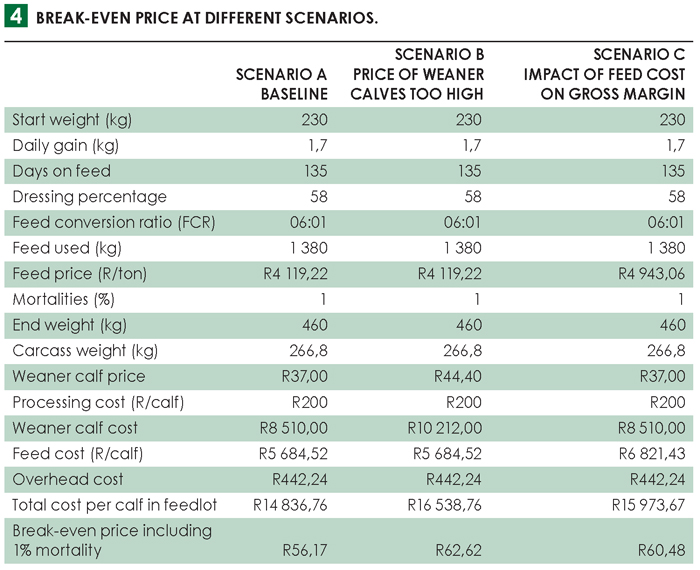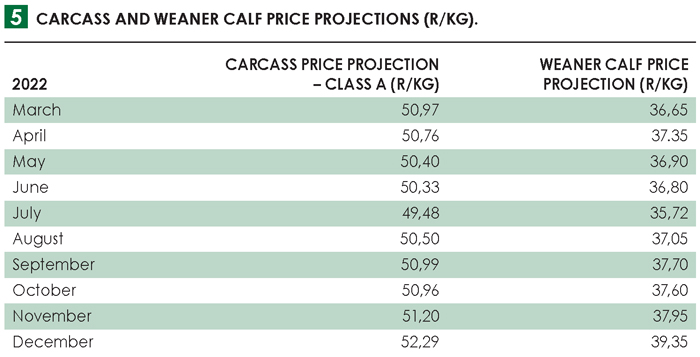
SA Graan/Grain editorial team
 Malcolm Moodie, livestock consultant
Malcolm Moodie, livestock consultantA decision faced by producers every year is whether to add value to their grain and livestock: Are they going to sell their grain and weaner calves or add value to both by feeding the calves in a feedlot or backgrounding them?
Self-produced calves or bought-in calves can be fattened in a feedlot or in pens or larger camps using commercially bought feed or home-grown feeds like maize, soybeans, planted pastures and hay. These calves can also be grown out on the veld or planted pastures to build the frame of the calf. The profitability of the feeding calves will determine whether it is possible to feed them or rather sell the grain and calves. Producers must not make the mistake to think inputs for the feedlot are for free – there is always a cost attached to inputs.
Backgrounding is a concept where the producer buy in or use a smaller and lighter weaner calf to grow the calf’s frame on the veld or pasture. The frame can be grown by between 80 kg and a 100 kg before the frame growth slows down. The idea is to use a supplementary feed at approximately 20% of the calf’s intake on grazing in order to have an average daily gain (ADG) of between 600 g and 1 kg, depending on the size of the animal.
The trick is not to increase the supplementary feed, because that will result in a smaller animal that reached its target weight too early resulting in a smaller frame, with a lower end weight and higher cost. The aim with backgrounding is to produce a calf with a bigger frame that is ideal to start feeding in the feedlot. This gives the feedlot the opportunity to decide how heavy the final carcass must be for their market, as the gain in the feedlot is about 200 kg to 220 kg.
But first, producers must make sure that there is a buyer that will buy the backgrounded calves. This can be a real problem. When backgrounding calves, producers must ensure that the fodder flow of the farm can support the extra livestock. It must be noted that the ideal time to background is on summer grazing and on planted pastures under irrigation in winter with additional bales on the side. In Table 1 an example of what can be expected from a backgrounded calf is presented.
 Out of the information in Table 2 it is clear that the larger the calf is, the lower the cost to produce the calf is. It is extremely important to buy or to start with the correct type of calf.
Out of the information in Table 2 it is clear that the larger the calf is, the lower the cost to produce the calf is. It is extremely important to buy or to start with the correct type of calf.
 Four distinct factors that will influence the profitability of a feedlot are the buying price of weaner calves or store cattle, the cost of the feed, the selling price of the finished cattle and the performance of the cattle as influenced by management. General feedlot production targets which will influence the profitability of a feedlot are presented in Table 3.
Four distinct factors that will influence the profitability of a feedlot are the buying price of weaner calves or store cattle, the cost of the feed, the selling price of the finished cattle and the performance of the cattle as influenced by management. General feedlot production targets which will influence the profitability of a feedlot are presented in Table 3.
 Basic feedlot economics
Basic feedlot economics
The profitability calculation of a feedlot operation is based on the price margin, the feed margin and other expenses. The price margin includes the difference between the purchase price and selling price of cattle influenced by beef price fluctuations, and the improvement in carcass quality due to feeding. The feed margin is defined as the profit or loss made by a feedlot as a result of live mass gain in relation to the cost of feed consumed. The best quality feed at the best price, good management, and the use of growth stimulants, can improve the feed margin by achieving optimal growth rates. Other expenses will include abattoir costs and losses, transport, interest on capital, labour and operational costs, processing costs, healthcare and mortalities.
Normally the feed needed for a feedlot calf will consist of 73% maize, 12% roughage, and 15% beef fattening concentrate, for example Beef Fat 33 from Molatek or SB 100 from Voermol. Usually, a 230 kg calf growing up to 460 kg will eat 1 380 kg feed in 150 days.
Pricing calculation example
Let’s say a producer has a weaner calf of 230 kg at a price of R38/kg. If a dressing percentage of 58% is assumed, it would mean that the producer could actually sell the carcass for R65,52/kg whilst the market price for an A2/A3 carcass is R50/kg. This will result in a negative price margin. The feed margin is calculated as the income from the added carcass weight above the cost to produce the added carcass weight. With a finalised weight of 451 kg, the added carcass weight during the 130 days in the feedlot will be 128,20 kg. Using the A2/A3 carcass price of R50, the income from the carcass will be R6 410. The feed cost to produce the added carcass weight is calculated by using the weight added during the growth period, the feed conversion ratio and the cost of the feed.
In this scenario, the feed cost will be calculated as 221 kg (added weight) x 6 (FCR of 6:1) x R3,80 (feed cost/kg) = R5 038,80. This will result in a feed margin of R1 371,20. The total gross margin can then be calculated using the following equation: (price margin + feed margin) x the loss factor less other costs like dipping and dosing of about R100 per calf. The loss factor is calculated from the mortality percentage. (If the mortality is 1%, the loss factor will be 0,99.) In the above scenario, the total gross margin will be a loss of R829,78 per calf. To calculate the net margin, other expenses as well as the income from the fifth quarter (skin and tripe) must be included in the calculation. Table 4 gives three examples showing the effect of weaner prices and feed cost on break-even prices.
 These scenarios illustrate the sensitivity of a feedlot’s profit. According to the information in Table 4 the break-even prices for different scenarios fluctuate. It is very important not to pay too much for weaner calves. Producers should also make sure that the price of the feed is not too high. They must focus on consumers in order to get a better price. All of this will have a big impact on the gross margin.
These scenarios illustrate the sensitivity of a feedlot’s profit. According to the information in Table 4 the break-even prices for different scenarios fluctuate. It is very important not to pay too much for weaner calves. Producers should also make sure that the price of the feed is not too high. They must focus on consumers in order to get a better price. All of this will have a big impact on the gross margin.
Producers can do all the above according to the book, but if the calf that is fed doesn’t have the potential to grow, the profit will be under pressure. The quality of a calf is important and plays a major role in the profitability of the feedlot – faster, more efficient growing cattle will require less feed and will spend fewer days in the feedlot to achieve the required final weight.
Carcass and weaner calf price projections
According to Table 4 the break-even prices differ dramatically. It is important to understand that the price of beef is influenced by factors outside the control of the producer. In Table 5 the expected carcass and weaner calf price projections done by Absa are shown. These prices can change, but it gives an indication of what to expect. Producers should compare the break-even prices with the expected prices and make a decision.
 With this information it is clear that producers must make use of expert representatives in helping to make a decision.
With this information it is clear that producers must make use of expert representatives in helping to make a decision.
Rules of thumb
- The weaner price must be less than 65% of the carcass price, with a calf price:beef price ratio of <0,55.
- To profitably finish a calf in a feedlot, 1 kg of carcass must be at least the value of 14 kg of maize. Maize:beef ratio of 14:1 and higher is advantageous.
- The feed margin must be positive.
- A positive price margin is ideal, but it rarely happens in industry.
- Mortalities must be kept at a minimum, <0,8%
- Don’t overfeed your calves in a backgrounding system.
- Marketing of backgrounded calves can be difficult.
For more information contact Pietman Botha at 082 759 2991 or Malcolm Moodie at 083 228 6257.





























